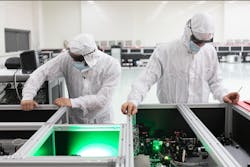
BUCHAREST, ROMANIA. On the afternoon of September 21st, I arrived in Magurele where a futuristic white building contrasts with a deep blue sky. It is a very warm day and the only sound we hear on the wide campus comes from the sprinklers. Except for a dog sleeping on the street, we could easily believe that we were on a Californian campus.
The building is the Romanian part of the European Extreme Light Infrastructure ELI. It comes with the extension NP for Nuclear Physics, as this is the direction in which the scientists here want to go. From a pure organizational point of view, ELI NP with its 200+ staff is part of the larger the Horia Hulubei National Institute of Physics and Nuclear Engineering (IFIN-HH), which is one of Romania’s major scientific institutions with a total of 800 people.
ELI NP hosts the most powerful laser in the world with a power of 10 PW. The ELI project itself was initiated by Nobel Laureate Gérard Mourou and funded by the host nations as well as the European Regional Development Fund. Magurele is located on the outskirts of Bucharest, the capital of the Central European state of Romania. A city where new office towers alternate with old residential buildings. And where the palace of the dictator Nicolae Ceaușescu is still enthroned above the center. Once the second biggest governmental building in the world, it hosts the Romanian parliament today.
Trouble in paradise
ELI NP has had some bad press recently, namely a news article from the science magazine nature. It was quite critical of the institute’s management, quoting heavy allegations from IFIN HH employees against former IFIN director Nicolae V. Zamfir, who is now project director for ELI NP. Employees of the laser institute, in turn, published an open letter supporting Zamfir.
If that conflict wouldn’t be enough, ELI NP was shaken by a problem that raised attention in Brussels: A variable energy gamma-ray beam system, the second major device beside the two 10 PW lasers, was delayed in delivery and Zamfir moved the contract to another supplier. This move was brought to court. And it led to a delay in project procurement. New delivery date for the gamma system is 2023. While the laser system is on plan, the delay with the gamma source is not, and thus, Romania is not included in the application to build a European Research Infrastructure Consortium ERIC. The whole discussion is now elevated to a governmental level.
The new ERIC will be crucial for the future financing of the common infrastructure. Allen Weeks, Director General of this organization, told me “After a decade of planning and construction, the newly formed ELI ERIC will organize the joint scientific user program and begin to coordinate the technical operation.”
So far ELI ERIC includes representatives of the Czech and the Hungarian government (host nations for the ELI branches ELI BL and ELI ALPS) along with Italy and Lithuania. Germany and the United Kingdom are founding observers.
“Romania with ELI NP should become part of ERIC, of course,” added Weeks. "There is an ongoing political discussion about how Romania can become an ERIC member and in parallel the ELI-NP facility is together in the EUR 20 Million European project IMPULSE with the other facilities to determine how to best cooperate on the scientific operations."
Running the most powerful laser of the world
When I read the nature news about a month ago I was wondering what people do there and what the status of the laser is. Thus, I contacted Ioan Dancus, head of the Laser Systems Department at ELI NP. He invited me to visit the facility. And he drove me through the lively traffic of the Romanian capital. Ioan is a laser physicist who remained there, even when a scientist’s salary was down to 50 USD per month. This has changed for quite some time already. The payment is fair now and other Romanians return home, joined by international scientists.
Ioan has responsibility for one of the most exciting laser systems in the world now. “In August we tested the whole system, just the final parabolas were replaced by a beam dump. And we reached 10 Petawatt with one shot per minute.” That is currently the highest laser power in the world.
The High Power Laser System HPLS at ELI NP has two huge arms with three main amplifier stages. Each stage can be used as beamline with chirp-compensated outlet for powers of 100 TW, 1 PW and 10 PW, respectively. The pulse duration is about 22 fs. The system has been built by the French company Thales, which also signed a 40 month warranty starting on January 1, 2020.
When Ioan showed me the NASA-style control room of the HPLS, the team was doing experiments with the 100 TW beam, i.e. with the front end and the first amplifier chain running. The whole system is based on TiSa-crystals, pumped by batteries of green lasers. It runs at 10 Hz. For the subsequent amplifier chains, the frequency is reduced to 1 Hz (1 PW) or to one shot per minute (10 PW).
In August 2020, the systems had been tested to deliver their nominal power throughout the entire amplifier and the 10 PW compressor in one arm. The missing off-axis parabolas will be delivered in November 2020 (1 PW) and mid 2021 (10 PW), enabling a series of commissioning experiments with all amplifier stages. Such commissioning experiments have been selected from a number of international submissions and the respective colleagues from abroad will participate in this next stage of tests.
Exciting science ahead
Once the parabolas are introduced, they will enable exciting and entirely new science. Such as measuring intensities beyond 1022 W/cm², which nobody has done before. Kazuo Tanaka, Scientific Director of ELI NP, gave me an introduction to this fascinating scientific challenge.
Kazuo is a well-known expert for laser fusion research. After retiring from his professorship at Osaka University he took a new job on the other side of the world at ELI NP. “It is a chance to build up something new. Here we open new horizons for laser nuclear physics,” he is enthusiastic about his new appointment.
For measuring the truly extreme intensities, he has plans for three different experiments. Based on simulations and data from lower intensities, they will test and compare results from accelerated electron, protons, and Gamma rays. He expects results of these measurements for Summer 2021. While commissioning experiments start later this year, the regular operation of the user facility with two 10 PW beams is currently scheduled to begin in 2022.
Three thoughts about the future
So the laser development at ELI NP is on schedule, a range of experimental halls are fully equipped. Their walls are made from huge concrete “bricks” which allow for easy reconfiguration. Also, the main laser hall offers plenty of space for future additions. But what will the future at ELI NP look like?
At first one has to see that the organizational crisis is serious. It might be seen as growing pains, which can occur in countries which haven’t had such a large-scale research infrastructure before. Nevertheless, it is up to all involved parties to solve the issues. Several hundred million of European development support and scarce Romanian funds have been invested and it would be a disaster for all involved people to see ELI NP shut down.
From a scientific point of view, the ELI facilities offer reason to think about new and amazing science. Gérard Mourou has drafted the opportunities in his Nobel Lecture “Passion for Extreme Light: for the greatest benefit to human kind”. Possible fields of applications are wide, having already been discussed in a chapter of the original ELI whitebook, and more have evolved since.
There is one more perspective that I would like to share: Ioan Dancus showed me what he calls “The laser playground”. These are two labs where students have the opportunity to receive hands-on training on real laser systems. They learn to clean mirrors, mount a laser crystal, or align a phase measurement system. Backed by such essential knowhow they can work as fully skilled laser operators. Is Ioan concerned that they will go abroad?
“I am more afraid that they go to other places around,” he confesses. Which, in the end, might not be so bad. Exchange of skilled people with other research institutions or even industrial companies is essential to grow and strengthen the local high-tech community. And that would have positive effects far beyond what we see now.
References:
“Current status and highlights of the ELI-NP research program“, K.A. Tanaka et al. https://doi.org/10.1063/1.5093535
About the Author
Andreas Thoss
Contributing Editor, Germany
Andreas Thoss is the Managing Director of THOSS Media (Berlin) and has many years of experience in photonics-related research, publishing, marketing, and public relations. He worked with John Wiley & Sons until 2010, when he founded THOSS Media. In 2012, he founded the scientific journal Advanced Optical Technologies. His university research focused on ultrashort and ultra-intense laser pulses, and he holds several patents.


